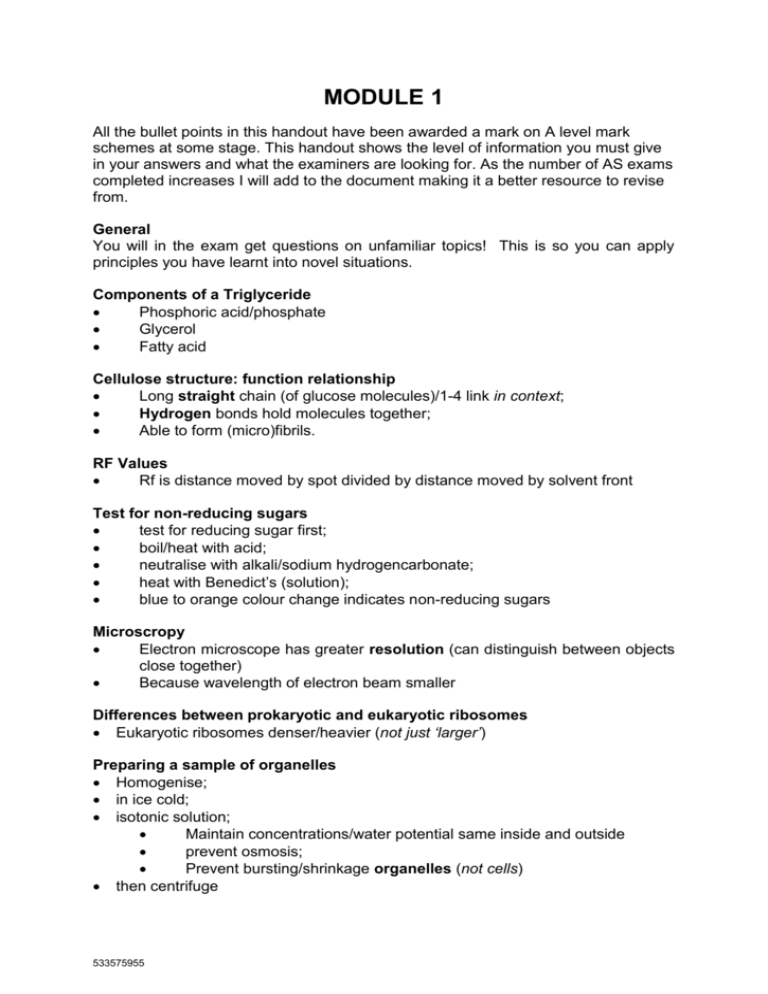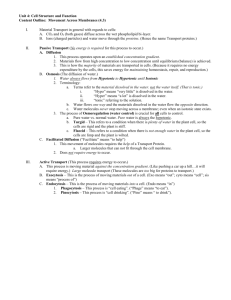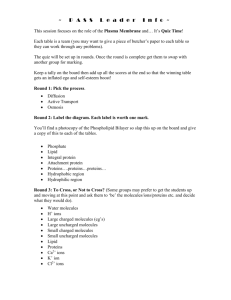exam bullet points
advertisement

MODULE 1 All the bullet points in this handout have been awarded a mark on A level mark schemes at some stage. This handout shows the level of information you must give in your answers and what the examiners are looking for. As the number of AS exams completed increases I will add to the document making it a better resource to revise from. General You will in the exam get questions on unfamiliar topics! This is so you can apply principles you have learnt into novel situations. Components of a Triglyceride Phosphoric acid/phosphate Glycerol Fatty acid Cellulose structure: function relationship Long straight chain (of glucose molecules)/1-4 link in context; Hydrogen bonds hold molecules together; Able to form (micro)fibrils. RF Values Rf is distance moved by spot divided by distance moved by solvent front Test for non-reducing sugars test for reducing sugar first; boil/heat with acid; neutralise with alkali/sodium hydrogencarbonate; heat with Benedict’s (solution); blue to orange colour change indicates non-reducing sugars Microscropy Electron microscope has greater resolution (can distinguish between objects close together) Because wavelength of electron beam smaller Differences between prokaryotic and eukaryotic ribosomes Eukaryotic ribosomes denser/heavier (not just ‘larger’) Preparing a sample of organelles Homogenise; in ice cold; isotonic solution; Maintain concentrations/water potential same inside and outside prevent osmosis; Prevent bursting/shrinkage organelles (not cells) then centrifuge 533575955 Structural adaptations of the chloroplast Contains chlorophyll/ pigments for light absorption Stacking/arrangement of grana/thylakoids maximises light catchment Stroma contains enzymes for photosynthesis Starch grains/lipid droplets store products of photosynthesis Structure of the membrane Phospholipids and proteins Phospholipid bilayer Arrangement of phospholipid molecules ‘tails to tails’ ”Floating protein molecules”/molecules can move in membrane Intrinsic proteins extend through bilayer Extrinsic proteins in outer layer only Detail of channel proteins/glycoproteins Facilitated diffusion Movement from high to lower concentration Use of carrier/channel protein Proteins specific Changes shape of protein and passes through channel/membrane No energy/ATP needed Active transport Movement against concentration gradient Use of carrier/intrinsic/pump proteins Protein specific (to ion) Energy/ATP required Energy used to change shape of proteins/attach ion to protein Ions moved through membrane as proteins change shape/position Differences between active transport and diffusion Active transport Diffusion May move substances against Substances moved down concentration concentration gradient; gradient; Requires ATP/energy; Does not require ATP/energy; Requires membrane proteins/carriers Does not (necessarily) require membrane proteins/carriers Active transport Active transport requires energy/uses ATP; Moves substances against concentration gradient Mechanism of active transport Carrier protein (in membrane); (reject: extrinsic protein, or just ‘protein’); Molecule transported by change of shape/’flipping’ of carrier protein; Energy used to attach molecule to carrier protein/change shape. (not just ‘ATP provides energy’). 533575955 Pallisade Mesophyll Cells Many chloroplasts containing chlorophyll for photosynthesis Thin cell walls allow maximum light penetration Definition of a tissue Cells all the same/similar structure/function Mechanism of enzyme action Activation energy reduced; Substrate attached to active site/formation of enzyme-substrate complex; Less energy required to bring (substrate) molecules together/to break bonds; Reaction occurs in small(er) steps; Change in shape of enzyme molecule (induced fit) brings molecules together/allows bonds to break/causes overlapping of electron orbits of substrates. Loss of enzyme activity at high temps Enzyme (molecules) denatured at 60°C/high temperature, or description of denaturing (eg vibration disrupts enzymes); Change (in shape) of active site; Change in tertiary/’3D’ structure/hydrogen bonds broken; Substrates no longer fit. The specialised gas exchange structures in fish Large number of lamellae Flattened epithelial cells giving short distance between water and blood/short diffusion pathway/ maximum diffusion gradient Countercurrent mechanism which maintains diffusion gradient along length of lamellae/prevents oxygen concentrations reaching equilibrium Role of ventilation mechanism in producing water flow over gills maintaining Circulation replacing blood diffusion gradients Counter-current in gills Water with high oxygen concentration meets blood with low oxygen concentration Difference in concentration maintained (across lamella) Diffusion gradient maintained Features of the human gas exchange system Large surface area (for diffusion); Thin alveolar wall/one cell thick/only 2 cells (from air to blood); Detail – eg flattened cells in alveolar/capillary wall; Ventilation (of alveoli) keeps oxygen concentration low; Flow/circulation of blood keeps oxygen concentration low; Maintains diffusion gradient/short diffusion pathway Digestion of starch overview Amylase Starch 533575955 Maltase Maltose Glucose Digestion of proteins Action of endopeptidases, break into short chains; Action of exopeptidases, break next to ends of chains; Polypeptides/dipeptides as (intermediate) products; Source of enzymes in gastric glands/pancreas/intestine lining; Amino acids formed; Absorption into blood (capillaries) in intestine wall. Absorption of fat in the gut Diffusion (of fatty acids and glycerol) into epithelial cells Recombination as triglycerides Chylomicrons formed Pass into lacteals/lymph (vessels) Test using Benedict’s solution Test using Biuret solution Boiled with hydrochloric acid, neutralised, then tested with Benedict’s solution Components of the plasma membrane Function Phospholipids Protein May act as hormone receptors May act as enzymes Involved in active transport How humans achieve efficient gas exchange One cell thick/thin (not thin membrane)/flattened diffusion/shorter diffusion pathway; Large surface area for faster diffusion; Ventilation to maintain a diffusion/concentration gradient; cells for faster Extracellular Digestion Secretion/release of enzymes(or described) not excretion; Absorption of/takes in (soluble) products/named soluble product/nutrients/food; Principle of extra-cellular digestion (eg breaks nutrients down outside cell) = 1 mark; Effect of temperature increase on enzyme reductions 533575955 Rate of reaction increases; Increasing temperature increases rate of movement of molecules/kinetic energy; Collide more often/substrate enters active site more often/more enzymesubstrate complexes formed; Up to optimum; Rate of reaction decreases; High temperatures cause denaturation/loss of tertiary structure/3D structure; By breaking specified bonds (not peptide bond); Active site altered/substrate cannot bind/fit/ Non competitive inhibition Inhibitor is a different shape to substrate; Blinds at position other that active site/allosteric site: Alters shape of active site; Substrate cannot bind/enzyme-substrate complex not formed; Competitive inhibition Molecules compete for same active site; Molecules similar shape (not same)/both complementary to/both fit active site; Prevents/slows production products; Biological roles of water Chemical reactions occur in solution; Allows transport/secretion/excretion/ dispersal of substances; High specific heat capacity (e.w) so minimises temperature fluctuations: High latent heat of evaporation so cooling effect of sweat/transpiration; Provides internal support eg hydrostatic skeleton/amniotic fliud/turgidity; Provides external support eg aquatic organisms; High surface tension eg pondskaters, cohesion-tension; Transparent eg allows light penetration for aquatic organisms; Less dense when frozen so ice floats and insulates; Reactant eg hydrolysis/photosynthesis; Lubricant eg synovial fluid/pleural fluid/mucus; 533575955









